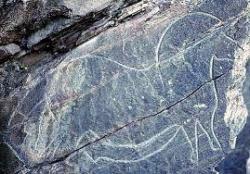INSTITUT SUPERIEUR D'ANTHROPOLOGIE
INSTITUTE OF ANTHROPOLOGY
ONLINE COURSES / COURS A DISTANCE
SUMMER TERM : JULY 2014
REGISTER NOW
PORTUGAL-  Ocreza Valley- Archaeologists Professor Dr George Nash and Dr Sara Garcês from the Earth and Memory Institute (ITM) in Central Portugal have been conducting fieldwork within the lower section of the Ocreza Valley for over 4 years. The fieldwork involves the recording of rock art within an 850 m stretch of the valley, at a point where the Ocreza flows into the Tagus River.In the recent past, both rivers have been subjected to water levels dictated by the various dams that interfere with seasonal river flow. The team directors, who organise each year a field school devoted to rock art, have since 2011 been recording six panels. One of these is an Upper Palaeolithic engraving of a horse which was initially discovered in September 2000. Since then it has been the focus for further research.The horse is engraved on a smooth angled-surface that forms part of a schist outcrop and appears to be headless. However, a recent tracing exercise in the summer of 2013 revealed that this figure did in fact possess a head. The style of the figure is representative of other engraved Upper Palaeolithic horses found elsewhere within the western part of the Iberian Peninsula. Among them, the famous Mazouco Horse in the Freixo-de-Espada-à -Cinta Parish in North Portugal and the Upper Palaeolithic open-air rock art engravings form the Côa Valley, an UNESCO World Heritage Site; here horse represents at least 35% of all engravings from the distant period of time.More important to this the landscape position in which the engraving is located. This and other horse engravings appear to stand close to naturally forming seasonal rapids. Although this fact is difficult to assess, the directors of the field team have timed visits to the Ocreza Valley to coincide with natural seasonal water flow. The archaeologists suggest in a forthcoming paper that there a deliberate link between engraved horses, their landscape position and the running water.
Ocreza Valley- Archaeologists Professor Dr George Nash and Dr Sara Garcês from the Earth and Memory Institute (ITM) in Central Portugal have been conducting fieldwork within the lower section of the Ocreza Valley for over 4 years. The fieldwork involves the recording of rock art within an 850 m stretch of the valley, at a point where the Ocreza flows into the Tagus River.In the recent past, both rivers have been subjected to water levels dictated by the various dams that interfere with seasonal river flow. The team directors, who organise each year a field school devoted to rock art, have since 2011 been recording six panels. One of these is an Upper Palaeolithic engraving of a horse which was initially discovered in September 2000. Since then it has been the focus for further research.The horse is engraved on a smooth angled-surface that forms part of a schist outcrop and appears to be headless. However, a recent tracing exercise in the summer of 2013 revealed that this figure did in fact possess a head. The style of the figure is representative of other engraved Upper Palaeolithic horses found elsewhere within the western part of the Iberian Peninsula. Among them, the famous Mazouco Horse in the Freixo-de-Espada-à -Cinta Parish in North Portugal and the Upper Palaeolithic open-air rock art engravings form the Côa Valley, an UNESCO World Heritage Site; here horse represents at least 35% of all engravings from the distant period of time.More important to this the landscape position in which the engraving is located. This and other horse engravings appear to stand close to naturally forming seasonal rapids. Although this fact is difficult to assess, the directors of the field team have timed visits to the Ocreza Valley to coincide with natural seasonal water flow. The archaeologists suggest in a forthcoming paper that there a deliberate link between engraved horses, their landscape position and the running water.
http://www.stonepages.com/news/archives/005249.html
ANGOLA -  Mbanza Congo - A delegation of national and foreign archaeologists are expected on Monday in the northern Zaire province, to fulfill with the third phase of archaeological diggings, under the preparation of the registration process of the city of Mbanza Congo in the list of Wolrd Heritage of UNESCO.According to a press note from the Ministry of Culture that reached Angop on Sunday, in this third phase, taking from April to June this year, it will be continued the diggings in Pindy a Tady area (Place of Smoking of the Bodies of Kings), Tady Dia Bukikua (Royal Palace and Cemetery in Álvaro Buta ward). Still in this phase, the document reads it will also open new areas for diggings, namely in Nkulumbimbi (former See Cathedral), Catholic Mission and S. António Church (former females mission). The delegation is coordinated by the Angolan archaeologist, Sónia da Silva Domingos, Angolan expersts Maria da Piedade and Ana Nóbrega, as well as seven foreiners.
Mbanza Congo - A delegation of national and foreign archaeologists are expected on Monday in the northern Zaire province, to fulfill with the third phase of archaeological diggings, under the preparation of the registration process of the city of Mbanza Congo in the list of Wolrd Heritage of UNESCO.According to a press note from the Ministry of Culture that reached Angop on Sunday, in this third phase, taking from April to June this year, it will be continued the diggings in Pindy a Tady area (Place of Smoking of the Bodies of Kings), Tady Dia Bukikua (Royal Palace and Cemetery in Álvaro Buta ward). Still in this phase, the document reads it will also open new areas for diggings, namely in Nkulumbimbi (former See Cathedral), Catholic Mission and S. António Church (former females mission). The delegation is coordinated by the Angolan archaeologist, Sónia da Silva Domingos, Angolan expersts Maria da Piedade and Ana Nóbrega, as well as seven foreiners.
http://allafrica.com/stories/201404140544.html?viewall=1